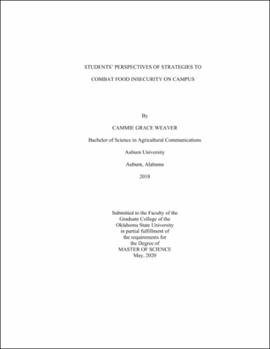| dc.contributor.advisor | Weeks, William G. | |
| dc.contributor.author | Weaver, Cammie Grace | |
| dc.date.accessioned | 2020-09-09T21:48:16Z | |
| dc.date.available | 2020-09-09T21:48:16Z | |
| dc.date.issued | 2020-05 | |
| dc.identifier.uri | https://hdl.handle.net/11244/325542 | |
| dc.description.abstract | As student populations diversify and enrollment numbers increase, food security among college students is becoming an issue. Dwindling financial aid and skyrocketing tuition charges have caused students to choose between paying tuition and paying for groceries. An analysis of 39 food insecurity studies on campuses revealed rates of food insecurity ranging from nine to more than 50%. While food aid in the form of SNAP, WIC, and the charitable emergency food system are available, few students participate. Maslow's Hierarchy of Needs was the conceptual framework for this study, with a focus on a student's physiological needs. Food insecure students may be unable to focus on their academic studies, placing student financial aid at risk. | |
| dc.description.abstract | The objectives were to assess food security status, describe the perceived effectiveness of strategies and potential behaviors to combat food insecurity, and determine students' awareness of food assistance resources. | |
| dc.description.abstract | A sample size of 391 was drawn from the undergraduate student population. Data was collected using a researcher devised instrument. Students used their smartphone to scan a QR code to access the instrument. Data was collected at three different locations on campus. | |
| dc.description.abstract | Nearly half of the respondents were found to be food insecure. Students believed anonymous types of aid to be the most effective strategies to fight food insecurity. While nearly 75% of respondents believed applying for SNAP benefits and accepting food from a food pantry would be effective, only about one-half said they would be willing to utilize these resources. Students were also generally unaware of their eligibility to receive benefits from SNAP and unaware of the local community food pantry. | |
| dc.description.abstract | Educational programming, including help in applying for SNAP benefits, and increasing awareness of a food panty have the potential to increase the number of students using available resources and decrease food insecurity on campus. | |
| dc.format | application/pdf | |
| dc.language | en_US | |
| dc.rights | Copyright is held by the author who has granted the Oklahoma State University Library the non-exclusive right to share this material in its institutional repository. Contact Digital Library Services at lib-dls@okstate.edu or 405-744-9161 for the permission policy on the use, reproduction or distribution of this material. | |
| dc.title | Students' perspectives of strategies to combat food insecurity on campus | |
| dc.contributor.committeeMember | Weeks, Penny Pennington | |
| dc.contributor.committeeMember | Norwood, F. Bailey | |
| osu.filename | Weaver_okstate_0664M_16776.pdf | |
| osu.accesstype | Open Access | |
| dc.type.genre | Thesis | |
| dc.type.material | Text | |
| dc.subject.keywords | college students | |
| dc.subject.keywords | food insecurity | |
| dc.subject.keywords | snap | |
| thesis.degree.discipline | Agricultural Education | |
| thesis.degree.grantor | Oklahoma State University | |
